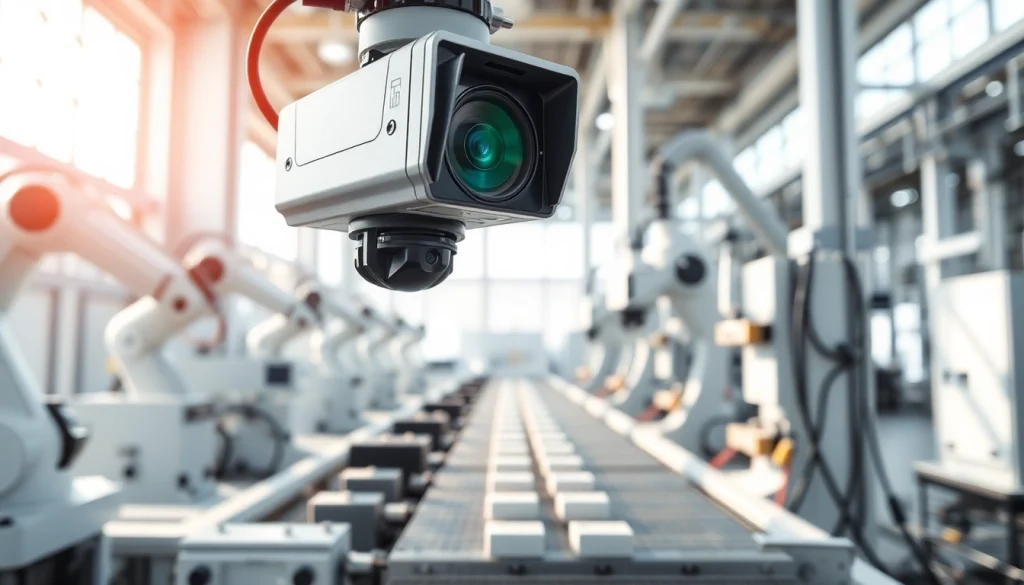Understanding Machine Vision: Applications, Benefits, and Best Practices

What is Machine Vision?
Machine Vision is an advanced technology that utilizes imaging systems, computational methods, and artificial intelligence to allow machines to interpret visual data. It is critical in automating processes that rely on visual inspections, significantly enhancing efficiency and accuracy in various applications. With a robust system in place, organizations can leverage machine vision technology to streamline operations, improve quality control, and reduce human error.
Definition and Core Concepts
At its core, machine vision refers to the capability of a computer or equipment to interpret visual information and make decisions based on that data. This technology encompasses both hardware (such as cameras and lighting systems) and software (for image processing and analysis). The primary components involved in a machine vision system include:
- Image Acquisition: This process involves capturing images using cameras or sensors. Lighting conditions and the type of camera used can significantly influence image quality.
- Image Processing: After acquisition, the images are processed using specialized software to enhance and analyze the captured data. This process includes filtering noise, analyzing features, and making decisions based on set parameters.
- Decision Making: Based on the processed images, the system makes decisions such as identifying defects, counting objects, or guiding machines during operations.
Differentiating Machine Vision from Computer Vision
While often used interchangeably, machine vision and computer vision are distinct in their applications and functionality. Machine vision is typically associated with industrial applications where the goal is to automate tasks like inspection, sorting, and guidance in manufacturing. It focuses on real-time analysis of visual data to drive immediate actions in specific processes.
On the other hand, computer vision encompasses a broader scope, including the interpretation of images in contexts unrelated to immediate action—such as facial recognition, scene understanding, and autonomous vehicles. Computer vision leverages machine learning and artificial intelligence to interpret visual data comprehensively.
Key Technologies Behind Machine Vision
Machine vision integrates various technologies that enhance its functionality:
- Cameras: The backbone of any machine vision system, cameras can range from simple industrial sensors to advanced multi-spectral imaging systems.
- Lighting: Proper lighting is vital for high-quality image acquisition. Specific types of lighting, such as LED or laser, may be employed depending on the application.
- Software Algorithms: Machine vision heavily relies on software for tasks such as image recognition, data analysis, and reporting. Algorithms can range from basic pattern recognition to complex machine learning models.
- Embedded Systems: Many machine vision applications utilize embedded processing units to perform real-time analysis and decision-making without relying on external servers.
Applications of Machine Vision
Industrial Inspection and Quality Assurance
In manufacturing environments, machine vision plays a crucial role in inspection processes. Automated inspection systems can detect defects in products more accurately than human inspectors. For instance, in the automotive industry, machine vision can check weld quality, paint condition, or even the alignment of parts during assembly.
Moreover, these systems can operate at high speeds, significantly enhancing throughput while maintaining quality standards. Some applications include:
- Defect Detection: Identifying surface flaws, missing components, or dimensional inaccuracies in real-time.
- Barcode and QR Code Scanning: Quickly reading codes to automate inventory management systems.
- Surface Inspection: Monitoring product surfaces for defects or contaminants in packaging industries.
Automated Assembly and Guidance
Machine vision systems can guide robotic arms in assembly lines, ensuring precision in operations that require exact positioning. For example, in electronics manufacturing, these systems can direct robots to place components on printed circuit boards (PCBs) accurately. The ability of machines to see and interpret the positioning of components speeds up assembly processes and reduces the likelihood of errors.
Applications in this space include:
- Pick and Place Operations: Robots equipped with machine vision can identify and pick items from a conveyor belt and place them in designated locations.
- Alignment and Guidance: Machine vision systems can help align components closely, ensuring correct assembly.
- Quality Checks During Assembly: Inserting a component correctly can be validated by a machine vision system, reducing the need for rework.
Machine Vision in Robotics and AI
The fusion of machine vision with robotics and AI has given rise to advanced systems capable of performing complex tasks autonomously. This is especially prominent in sectors such as logistics and agriculture. For instance, in warehouse automation, robots can navigate, sort, and handle packages using vision systems to identify their locations and determine the best path.
Other applications include:
- Autonomous Vehicles: Machine vision is integral in helping self-driving cars perceive their environment, identify obstacles, and navigate safely.
- Agricultural Robotics: Robots equipped with machine vision can identify ripe fruits, assess crop health, and even perform precision weeding or harvesting.
- Medical Robots: In healthcare, machine vision systems assist robots in performing surgeries with precision while ensuring patient safety.
Benefits of Implementing Machine Vision Systems
Enhanced Efficiency and Productivity
One of the most significant benefits of implementing machine vision systems is the enhancement of operational efficiency. Automated systems can operate continuously without fatigue, allowing for higher production rates and reduced turnaround times. Additionally, machine vision systems can work at speeds unattainable by human workers, leading to higher output and faster feedback loops.
Cost Savings and Waste Reduction
By automating visual inspection processes, organizations can significantly reduce labor costs associated with manual inspections. Furthermore, machine vision systems help reduce waste by identifying defects early in the production process, decreasing the likelihood of faulty products reaching customers. The early identification of defects allows organizations to refine their processes and material usage, contributing to increased sustainability.
Improved Accuracy and Consistency
Machine vision systems operate based on precise algorithms that are not influenced by human error or fatigue. This leads to a high degree of accuracy and consistency across operations. For instance, in a production line, every product can be inspected using the same criteria, ensuring that all meet quality standards without variance.
Challenges in Machine Vision Implementation
Technical Limitations and Hardware Considerations
Despite its many benefits, implementing machine vision technology can come with challenges. One key challenge is the technical limitations of the hardware used, such as the resolution of cameras or the sensitivity of sensors. Selecting appropriate hardware that fits specific applications is crucial, as inadequate technology can lead to suboptimal performance.
Moreover, variations in lighting conditions and surface textures can affect image clarity and, subsequently, accuracy in detection. Thus, an investment in advanced hardware and robust lighting solutions is essential.
Software Integration and Data Processing
Integrating machine vision systems with existing software and processes can be complex. Organizations must ensure that their data processing capabilities align with the outputs of machine vision systems. This may require system upgrades or the development of new software solutions that can handle the high volume of data generated by vision systems.
Ensuring compatibility with legacy systems and overcoming potential data silos is often a significant hurdle in successful machine vision implementation.
Quality of Camera and Lighting Setup
The quality of camera systems and the setup of lighting are critical to the effectiveness of machine vision applications. Poorly designed lighting can lead to shadows and glare, affecting the quality of the acquired images. Selecting the right combination of cameras with suitable resolutions and appropriate lenses, coupled with strategically positioned lighting, is paramount in achieving optimal results.
Future Trends in Machine Vision Technology
Integration with AI and Machine Learning
The future of machine vision is likely to be significantly influenced by the infusion of artificial intelligence and machine learning technologies. These advancements will allow for more intelligent processing and analysis of visual data, enabling systems to learn and adapt over time. This means that machines will be capable of identifying novel defects, optimizing processes without human intervention, and enhancing operational efficiencies.
Advancements in Imaging Technologies
As technology progresses, imaging devices will continue to evolve. The development of higher-resolution cameras with advanced capabilities such as multi-spectral imaging will enhance the capabilities of machine vision systems further. This will open new horizons for applications in sectors such as agriculture, where plants can be assessed based on spectral data for health monitoring.
Expanding Applications Across Industries
Machine vision is not limited to manufacturing; it is expanding into various fields, including healthcare, agriculture, and food safety. The potential for new applications in these industries is vast. In healthcare, for example, machine vision can assist in diagnostics through analysis of medical images, while in agriculture, it can be used for precision farming practices.
As organizations increasingly recognize the value of machine vision, its adoption will likely grow, resulting in innovation in applications and technologies.







